Text



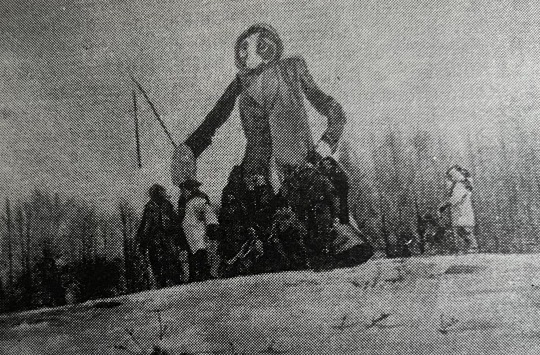
užgavėnės
631 notes
·
View notes
Text

Ambar (barn), view of masonry openings
Izvor, Macedonia
This view of the barn, from the garden edge, shows the doorway and small window openings in the rubble masonry of the ground level interior.
(photo 1991)
14 notes
·
View notes
Text

Ambar (barn) and outbuildings
Izvor, Macedonia
Izvor is a village in the Kičevo municipality of western Macedonia, located in the Treska valley south of Bistra mountain. This small hay-drying structure has a stone enclosed space, upper level and clay-tiled roof. A upper level wooden frame with diagonal bracing is clad with thin wooden strips spaced to allow air circulation for the interior and to support the drying hay.
(photo 1991)
12 notes
·
View notes
Text

Ambar (barn) to store hay and grains, front view
Kolari, Macedonia
The barn is sited within a walled enclosure. The lower level is constructed of stone with horizontal wooden reinforcement and an enclosed storage area. Above, light timber framing forms the upper level floor and structure that is clad with wooden strips spaced apart to permit air circulation. A wooden stair gives access to the upper level. A simple cart sits in the foreground.
(photo 1991)
14 notes
·
View notes
Text

Ambar (barn) to store hay and grains, rear view
Kolari, Macedonia
Kolari is a small farming village in the municipality of Zajas, in western Macedonia. This simple structure is used for various drying and storage purposes, as evident in the light frame of the upper level, enclosed with woven branches. It has a covered gallery facing the fields.
(photo 1991)
12 notes
·
View notes
Text

Typical Village House
Gari, Macedonia
As with the Serafinofski house, thick stone walls reinforced with horizontal wood bands fit this traditional Mijak house to the steep slope and form its ground level. The south-facing parts of the upper floor are of lighter wood frame-and-infill construction, and incorporate a chardak space with shuttered openings. A slate-clad pyramidal hip roof caps this cubic dwelling.
(photo 1988)
19 notes
·
View notes
Text
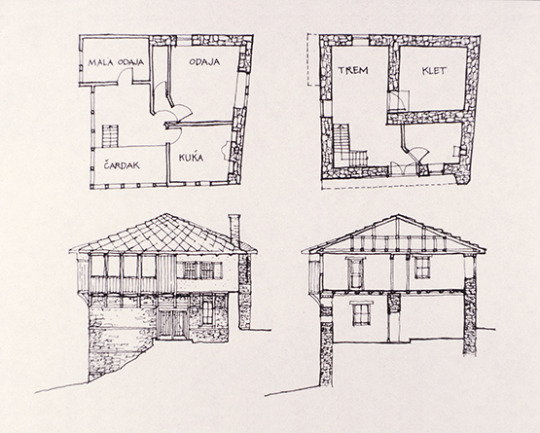
Drawings of Serafinofski House
Gari, Macedonia
This compact kuќa in Gari protects the owners from the winter season with its thick masonry walls. Spaces for summer living are of lighter construction, on the upper floor. This set of sketches by the authors in 1993 from the Republic of Macedonia's Institute for the Preservation of Cultural Monuments documents.
LEGEND
trem (porch, vestibule)
klet (cellar)
kuќa (hearth, kitchen)
odaja (room, bedroom)
mala odaja (small room)
čardak (sitting space)
doksat (raised sitting area)
25 notes
·
View notes
Text
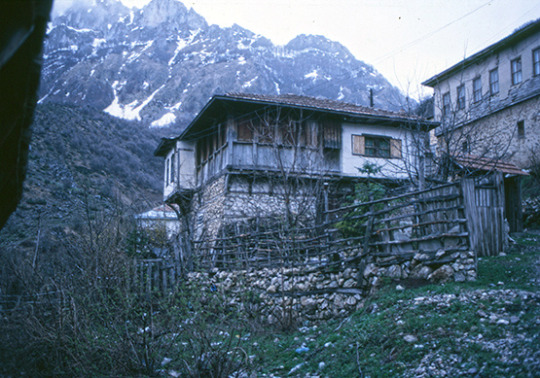
Serafinofski House
Kuќata na Serafinofski
Gari, Macedonia
Gari is a small village in the western mountains of Macedonia within the municipality of Debar. It was originally inhabited by Miyak people, a minority group in the country. The village was first noted in documents from the 15th century. The master wood-carver Petar Filopović (Filopovski) and his brother Marko lived in the village but traveled to create some of the finest iconostases in Macedonia during the early 19th century. The village is reputed to have some of the best examples of traditional Miyak dwelling structures.
(photo 1988)
30 notes
·
View notes
Text
Bulgarian Folk Themed Clothing
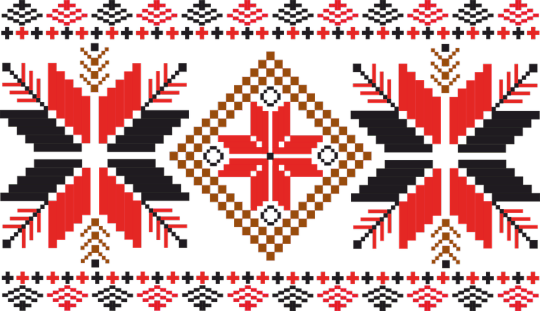
I’ve recently decided to incorporate more folklore and traditional motifs into my daily life and wardrobe. So with that in mind, I decided to share some of the stores I’ve found that promote the cultural heritage and motifs of traditional outfits.
€ - €€ Етно Стил / Ethno Style* - from plain t-shirts with added folk motifs to full blown traditional costumes, the website has a decent collection of items you can add to your daily wardrobe. (They also have socks!)
€ - €€ Българка / Bulgarka - ranging from trinkets, accessories, and simple t-shirts to dresses, tunics, scraves, and prints.
€ - €€€ БългаранЪ / Balgaran - a website designed specifically to deliver Bulgarian-related items, such as handcrafted items, books, household objects, textbooks, clothing, board games, puzzles, cosmetics, and accessories of all sorts, all over the world. This might be the ideal online retailer for people living outside of the EU.
€ - €€€ Бабина Ракла / Grandmother’s Chest - a gift shop that offers products with traditional motifs, including jewelry, purses, wallets, scarves, t-shirts, and copper kitchenware. However, the t-shirts are not embroidered, they are printed. I would recommend the collection of scarves because they seem to have combined forces with Rose&Pepper, who previously only sold through Facebook.
€ - €€€ Стефи Стил / Stefi Style* - embroidered t-shirts, dresses, tunics, socks, and more! Mix and match or just get an individual item to suit your needs.
€ - €€€ Веникс / Venix - t-shirts, blouses, or full on outfits with embroidered traditional motifs. There’s also a “sailor” section since most of their stores are located on the Black Sea, and that’s another vibe they’re going for.
Note: I have a shirt from here! It’s a very light, airy fabric and the embroidery is very delicate. The merchant told me it can be washed regularly in the laundry machine and that the white base fabric won’t stain from the colourful embroidery.
€ - €€€ Етно Шоп / Ethno Shop* - ceramics, pottery, textiles, including leather and hand-woven crafts, clothing such as t-shirts with stamped шевици, folk costumes, accessories, and even a wool yamurluk.
€€ Везба / Vezba - comfortable t-shirts, blouses, hoodies, hats, and more! You can browse by the type of item, colouration, or even the шевица used on the article of clothing - there’s a page dedicated to each where the anthropological analysis of each used shevitsa is available.
Note: I have two t-shirts from here and the embroidery’s great, but the quality of the shirt itself is debatable. It’s definitely sturdy but it’s some kind of polyester-mix type of textile, so it’s very stretchy and comfortable but prone to smelling really, really badly after you wear it.
€ - €€ Караконджул / Karakondzul - ethno accessories, trinkets, repetition dance gear, small children’s folk outfits, and a focus on the tale of the karakondzul - a dark creature from Bulgarian folklore, similar to a deformed vampire. But these karakondzuli are different - they are kind, and seek to help humanity be pure of heart. Which is why they have adorable plushies with their likeness!
€ - €€€ Китна / Kitna - an online store with adorable souvenirs, gift ideas, and especially interesting knitted jewelry and other accessories with traditonal folk motifs. There are some clothing items such as 100% wool coats, but the primary products are trinkets and jewelry, and an adorable For Kids section that mainly includes pillows with illustrations.
€ - €€€ Чаршия / Charshia - an online shop that offers hand-made crafts, including items of clothing. They showcase the work of artisans who use the traditional methods of production to keep the traditional alive and kicking. You can build a full costume or buy individual items and use them as you please.
€ - €€€ Магазин Млъчков / Mlachkov Store* - provides a catalogue where you can find anything from socks to go with your traditional costume, to household textiles for an authentic Revival period house. Тhey sell authentic items, as well as newly produced - you can buy an antique scarf or gas lamp or whatever else you find.
€€ - €€€ Балкан фолк / Balkan Folk* - A store that offers traditional costumes, accessories, folk music CDs, and some souvenirs. The website itself also have a sweet retro vibe but it is fully operational and active. You can buy full costumes or separate elements.
bonus: Балкан фолк каталог / Balkan Folk catalogue - Balkan Folk also has a very detailed catalogue with full traditional costumes, including (Bulgarian) instructions on how to order the correct size without having to visit the atelier in person. I’d say this is an excellent art reference resource, too!
€€ - €€€ Светулка / Svetulka - a family business that embroiders modern clothes with traditional motifs, such as shirts, t-shirts, jackets, dresses, and more. They use exclusively natural materials like linen and cotton, though there might be a few exceptions somewhere on their website.
€€ - €€€ Аския / Askia* - ranges from t-shirts and dresses to traditional pieces that can be worn as a full costume or separately to have your desired look.
Note: They use a different sizing to most other websites and brands, and it took asking about five times to be told what size would fit me. I kept asking “What sizes do you use? I need the equivalent of an S” and being told to measure myself… It was the most absurd email chain I’ve been a part of in a while and felt passive-aggressive, so I doubt they would be helpful if you need customer support.
€€€€ Везе / Veze - business casual to formal wear with a touch of tradition; with the option to have the item tailored to your size.
? Шевица / Shevitsa* - a company that specializes in hand-sewn textiles, and is open to doing custom orders. If you want to recreate the outfit you found in a museum or in a picture of your grandmother, they could give it a shot. Since they tailor everything and work from scratch, there are no listed prices.
? Етно Рай / Ethno Heaven* - a workshop based in Tryavna that works with custom orders, and has no listed prices. You can order a unique piece that’s your own take on any ethnographic region’s outfit or a costume fully in line with the traditional style you want to emulate.
websites marked with * offer full traditional costumes

last updated: June 5th 2023
166 notes
·
View notes
Text

Iosif Berman (Romanian/Jewish, 1892–1941)
Boy embraces a girl, Drăguș, Țara Făgărașului, 1929
Muzeul Național al Satului "Dimitrie Gusti" / Europeana
181 notes
·
View notes
Text

Traditional dwelling 5
Kuќa 5
Galičnik, Macedonia
This dwelling shows the shifting of stones and vulnerability of these structures in these highlands. It has the basic three levels with exterior access for each level. The window and door openings have wooden lintels except at the uppermost level where dressed stones form the opening for the entry door.
(photo 1991)
41 notes
·
View notes
Text
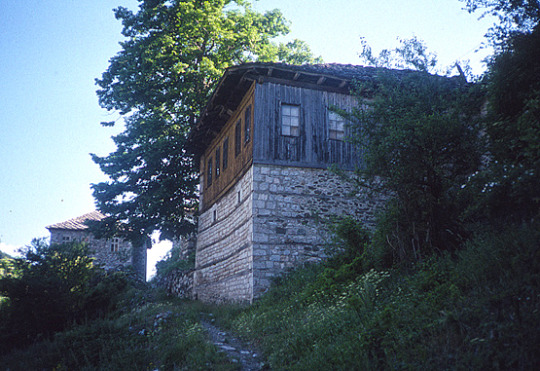
Traditional dwelling 4
Kuќa 4
Galičnik, Macedonia
The wooden clad čardak was typically framed with lumber studs and infilled with a combination of cobble stones and plaster. The studs were interconnected with diagonal lumber pieces to reinforce the studs and served to support the infill material. The čardak elements were either covered with wooden board and battens (as in this case) or with a layer of thin wooden strips and a plaster coating.
(photo 1991)
11 notes
·
View notes
Text

Traditional dwelling 3
Kuќa 3
Galičnik, Macedonia
The majority of the surviving dwellings date from the late eighteenth to early twentieth centuries during the period when the Ottoman Empire controlled the region. Since the village has been designated a cultural site, regulations have been put in place to restrict the existing buildings and their uses and standards for repair and modifications have been established. These regulations sometimes make it difficult for building owners to afford to bring the buildings back to life.
(photo 1991)
16 notes
·
View notes
Text

Drawings of kuќa similar to Tomoski House
Galičnik, Macedonia
This kuќa in Galičnik is remarkably similar to the Tomoski house but has a number of minor differences. The layout of the dwelling follows the grade with storage rooms built into the earth.
LEGEND
trem (porch)
pretprostor (anteroom)
odaja (room, bedroom)
kiler (cellar)
čardak (sitting space)
kuќa (hearth, kitchen)
paraklis (chapel)
(drawings by authors 2016 after S. Brezoski 1993)
11 notes
·
View notes
Text

House of Tomoski
Kuќata na Tomoski
Galičnik, Macedonia
This three storey dwelling previously belonged to the Tomoski family. The roof has the traditional stone panels (ploča) and masonry walls with wooden reinforcing strips. The reinforced masonry is an important element in Macedonia since seismic activity is common. The projecting corner čardak has additional brackets to support this element. The structure has become a house museum.
(photo 1991)
18 notes
·
View notes
Text

Traditional dwelling 1
Kuќa 1
Galičnik, Macedonia
The dwelling sits beside the church of saints Peter and Paul. This dwelling has three levels. The coursed stone is reinforced with horizontal bands of wood that connect to interior bands by wooden cross pieces. The lowest level of the house was used for animals with separate rooms for storing food. The intermediate level contained rooms for living and the upper level contained the kitchen and common space. The common space is wooden framed and the projecting areas are referred to as čardaci (chardaks). The roofs were traditionally covered with stone panels. (photo 1991)
5 notes
·
View notes
Text
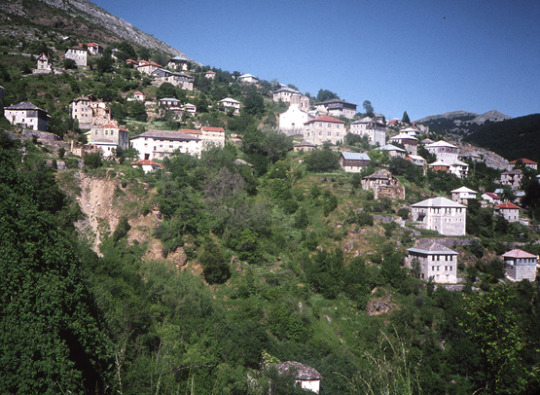
View from the Galičnik road
Galičnik, Macedonia
Galičnik is a village in the Reka region of western Macedonia. It sits 1400 meters above sea level and below Bistra Mountain and Lake Mavrovo nearby to the north. The village was first noted in the 10th century and is famous for the fortress-like stone dwellings and its masons and craftsmen. In 1975 it was designated as an important cultural site. The inhabitants (ethnic Miyaks) still raise cattle and sheep and also work as masons and craftsmen. The Reka region borders Albania and is named for the Radika river valley and its mountain tributaries. (photo 1991)
12 notes
·
View notes